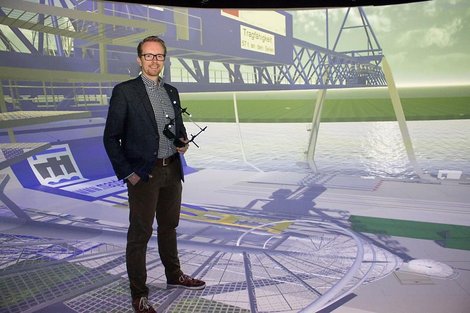PortForward – The Digital Port:

The Fraunhofer IFF Magdeburg and the TRANSPORTWERK Magdeburger Hafen GmbH present a virtual model for the port operations of the future at the transport logistic in Munich.
The handling of goods at the port is a sensitive, time-critical and failure-prone interaction between a variety of factors. The European PortForward research project is developing digital concepts and solutions so that port infrastructures and processes can be made significantly more cost- and environmentally efficient. The Fraunhofer Institute for Factory Operation and Automation IFF Magdeburg is leading the research, and in cooperation with the TRANSPORTWERK Magdeburger Hafen GmbH, is presenting a virtual model for the port operations of the future at the transport logistic in Munich.
The manager of the port has an “all-around view” of the logistics on his container terminal. He can see where the handled goods are unloaded and loaded and where they are stored. He is able to steer the flow of goods across the port area on a targeted and efficient basis – as yet, however, this is just a virtual image at the Port of Science in Magdeburg. It is being projected onto a big screen in the Virtual Development and Training Centre of the Fraunhofer IFF, which is only about four kilometres downstream from the actual operations at the Port of Magdeburg.
The scientists call their Mixed Reality Laboratory – the biggest of its kind for the presentation of interactive visualisations in Europe – the Elbedome. It is part of the cutting-edge research infrastructure at the Fraunhofer IFF Magdeburg.
Here in the virtual space, digital technologies are tested in a variety of scenarios for the port of the future. In the European PortForward research project, 13 partners from Germany, Spain, Italy, Greece, Great Britain and Norway are developing solutions to make the operation of small and medium-sized ports more intelligent. The international research network is being led by Christian Blobner, a scientist at Fraunhofer IFF.
Looking into the future through VR glasses
Christian Blobner explains that the knowledge about processes, procedures and capacities at the port exits for the most part in the minds of the employees. When he looks through his VR glasses, he can see the port operations of the digital era. Through networking with the Internet of Things, suitable solutions would automatically be found to make the port logistics economical and cost-saving and to increase the environmental efficiency. "As a result of the PortForward research project," explains the scientist at the IFF, "we want to provide the port operators with a modular platform to make the operation of the port and its infrastructures more efficient. In this respect, the focus is on the digitalisation, networking and analysis of information and data in the Internet of Things.”
Christian Blobner goes on to discuss the Fraunhofer's own digital platform for cooperation and technology, Virtual Fort Knox. A fitting name, since it relates to an open but secure innovation system for the Industry 4.0. This cloud infrastructure is to be used to provide port operators with a variety of individually combinable services.
Multifunctional terminal requires specific solutions
It’s the same at the Port of Magdeburg: together with TRANSPORTWERK Magdeburger Hafen GmbH, the Fraunhofer IFF is developing digital solutions which primarily support warehousing and logistics on the site of the Port of Magdeburg. In this respect, the partners rely on the interplay between a variety of technologies such as sensors, cameras and mobile GPS units for trucks.
As a special attribute of the Inland Port, the Managing Director of the Port Dr. Heiko Maly makes mention of the multifunctional terminal, a place where containers aren’t just handled or stored, but where goods of various types and sizes are as well. This means fulfilling a variety of requirements in terms of the processes, procedures and IT solutions. "We have planned a variety of steps for the introduction of the necessary IT systems," says Maly, who refers to a digital warehouse management system which is customised to the specific requirements of the multifunction terminal as a basic requirement. A security concept consisting of organisational and IT-technical measures and tools would have to be adapted to this.
3D-VR port model for the transport logistic
The Transportwerk Magdeburger Hafen GmbH and Fraunhofer IFF are attending the transport logistic in Munich with an interactive 3D-VR model of the Port of Magdeburg. “The model provides detailed information about the port area,” explains Christian Blobner. "It is true to scale and will be developed further as the PortForward project progresses to interactively retrieve information on cargo handling and storage infrastructures, facilities and capabilities. The presentation will be displayed on a large stereoscopic 3D display. With 3D glasses, visitors to the trade fair can experience an impressive visualisation and interaction."
The IFF scientist also envisages further development work on the VR port model. The focal points of the research also include the "digital twin" for port infrastructures. "To support the operational decision-making for example, various scenarios could be run through in the digital twin," says the IFF scientist, who also talks about assistance systems that can be developed and tested here before they are used in reality.
The Managing Director of Transportwerk Magdeburger Hafen GmbH considers this a necessary step towards making essential production processes more efficient and transparent in the age of digitalisation.
Author: Kathrain Graubaum
